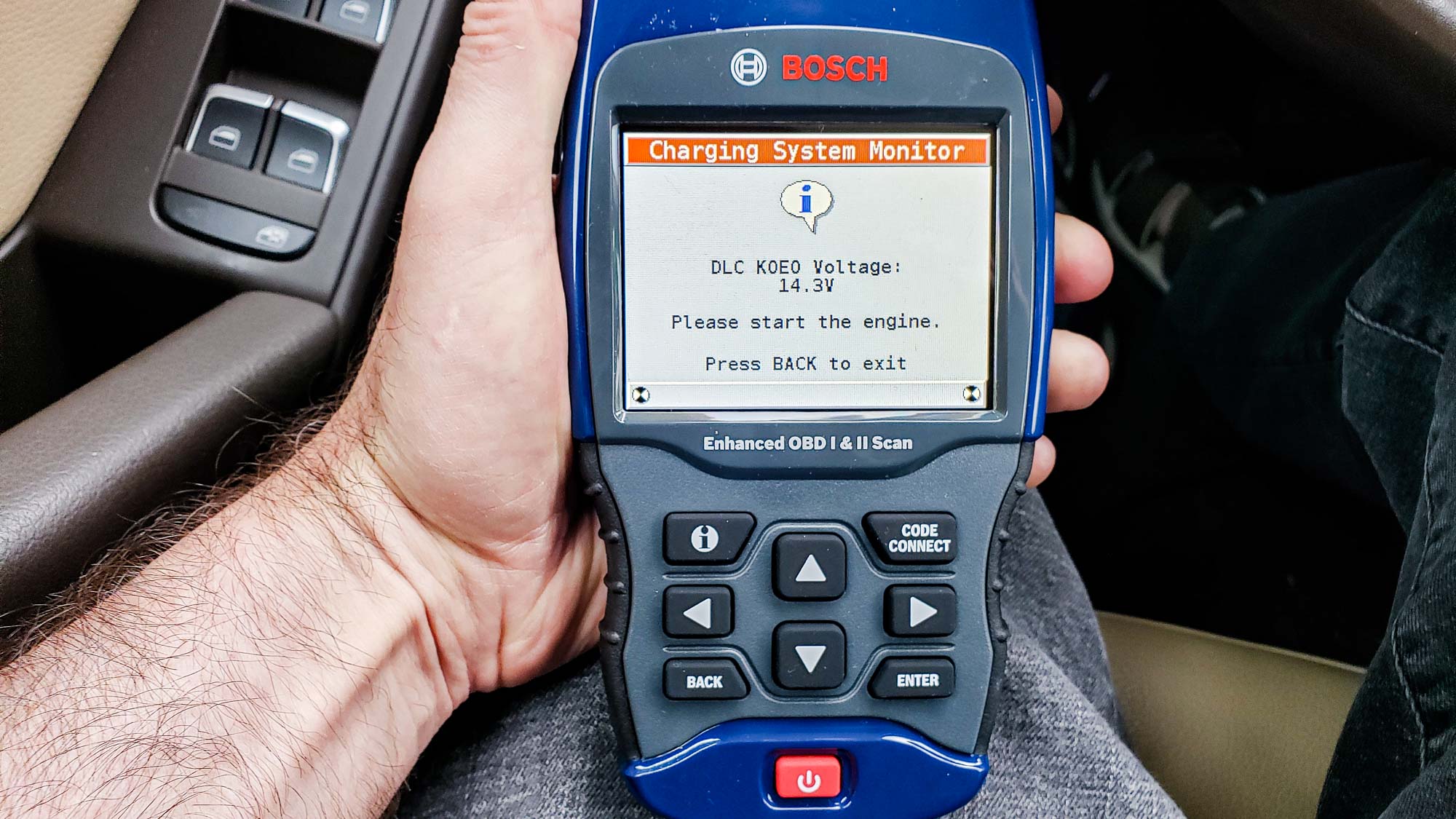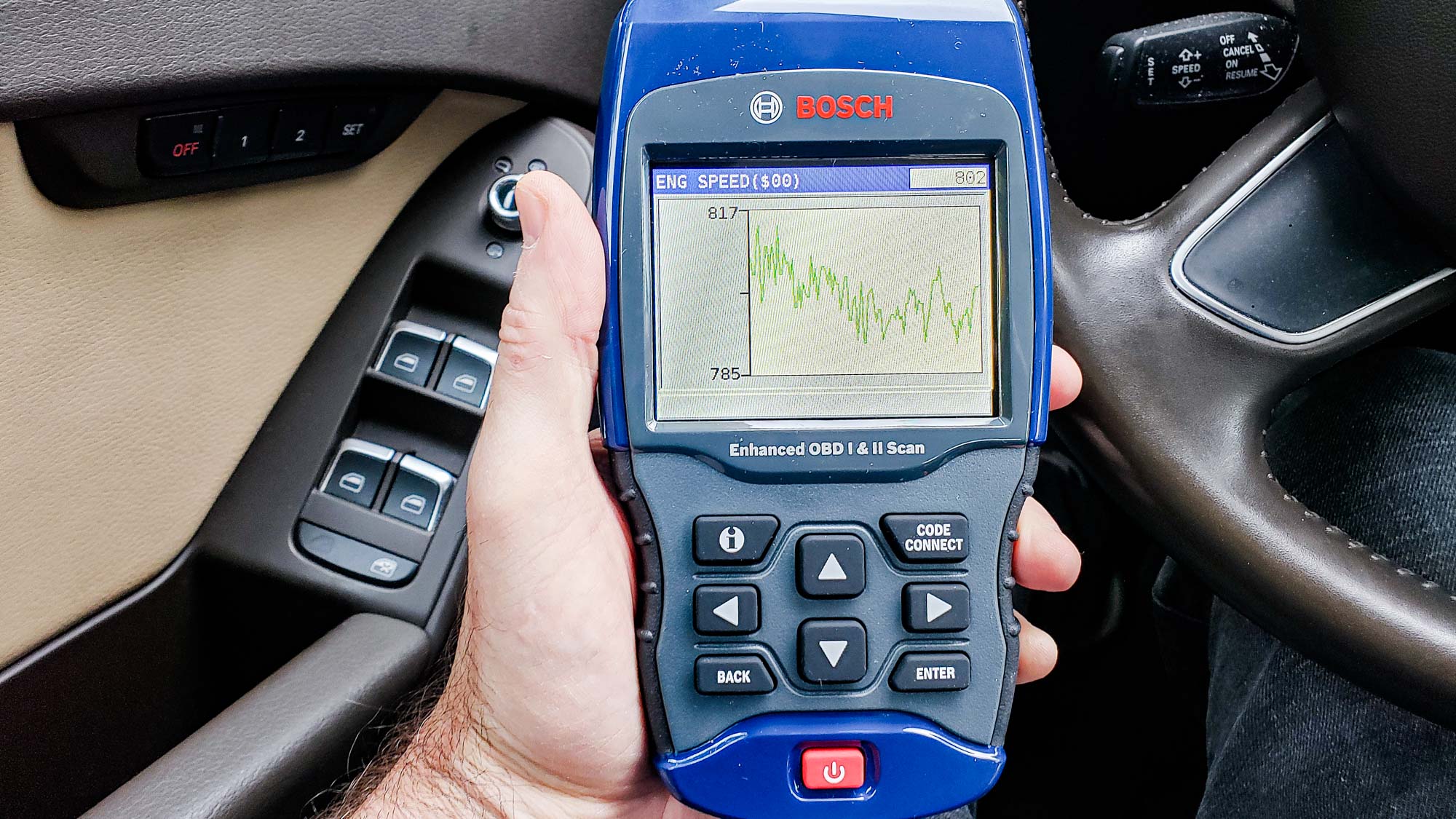Tom's Guide Verdict
Bosch's OBD 1300 automotive diagnostic scanner excels by including cables to connect with pre-1996 cars. But the scanner doesn't come with any instructions and can get heavy.
Pros
- +
Small
- +
Comes with cables for pre-1996 vehicles
- +
Includes repair suggestions
- +
Can reset oil change light
- +
Bright blue case
Cons
- -
Can get heavy
- -
Requires four AAA batteries
- -
No manual or quick-start guide
Why you can trust Tom's Guide
Size: 6.8 x 2.6 x 1.0 inches
Weight: 10.5 ounces (1.4 pounds with 84-inch cable)
Live data: Yes
Display type and size: Color, 3.5 inches
Number of keys: 8
Bluetooth: No
Handheld: Yes
Warranty: 1 year
With the cables and features to work with a variety of vehicles, including some that pre-date the OBD-II standard, the Bosch OBD 1300 automotive scanner is for anyone who often works with cars built before 1996.
It can turn off the oil-change light and suggest needed repairs, but the Bosch OBD 1300 requires batteries and is on the heavy side. Still, at $200, it’s a steal for those with a classic '80s or '90s car in the driveway.
Read on for the rest of our Bosch OBD 1300 review.
Bosch OBD 1300 Pricing and availability
The $249 Bosch OBD 1300 is a crossover scanner that works with the latest cars as well as with older models. The company also sells inexpensive OBD-II scanners that cost as little as $59, as well as professional models that can cost $4,500.
Bosch OBD 1300 Design
As the world's largest maker of automotive components, Bosch knows a thing or two about vehicle diagnostics. The company's OBD 1300 scanner is deceptively small at 6.8 x 2.6 x 1.0 inches, taking up about 15% less space than the rival Innova CarScan Inspector 5310.
The 10.5-ounce Bosch scanner is a lightweight on its own, but once you add its short OBD-II cable and the included 72-inch extension cord, the total weight rises to a ponderous 1.4 pounds.
The scanner's bright-blue finish is a departure from traditionally black OBD-II scanners and has soft rubber insets for your fingers. The scanner's eight keys and text-based navigation make it easy for the user to get the hang of the OBD 1300, but the keys are stiff and sometimes require a second press.
Get instant access to breaking news, the hottest reviews, great deals and helpful tips.
Despite its small size, the OBD 1300 squeezes in a 3.5-inch color screen, 20% larger than most handheld scanners.
The scanner's eight-button interface includes four directional buttons. There's also an on/off key, because the OBD 1300 requires either four AAA batteries or external power. It has a cigarette-lighter adapter but no input for AC current. There is a mini-USB port for updating the Bosch OBD 1300's software, and the scanner comes with a carrying case.
Because it comes with a variety of older OBD-I cables, the Bosch OBD 1300 spans the worlds of old cars and new. It starts with a foot-long OBD-II cable and a 6-foot extension cord, resulting in a 7-foot total length — the longest you're likely to see in an OBD-II scanner.
There are seven extra cables for the now-obsolete diagnostic standards retroactively labeled "OBD-I." These are for the ALDL (1980s GM models), EEC-IV (1980s Ford cars), SCI and LH (1989 through 1995 Chrysler vehicles) standards, as well as round and rectangular Toyota plugs (1984 through 1995).
All eight cables, including the OBD-II one, plug right into the scanner body's old-style 15-pin port and also work with the extension cable. If you have a car built between 1980 and 1995 that needs diagnosing, this is the scanner to get.
Bosch OBD 1300 Performance
After I plugged it in, the OBD 1300 automatically detected my car's model, but I would also have been able to determine the model manually by answering a set of five questions that the scanner presented. I was able to use the scanner to read the vehicle identification numbers (VINs) on my two test cars.
The Bosch scanner ran a cylinder-balance test and turned off the dashboard's oil light. It also found my artificially introduced fault (I had manually unplugged the oil-temperature sensor) and was able to turn off my Check Engine light.
The scanner's CodeConnect database holds the details on more than 26 million repair suggestions. It can check the status of the anti-lock brakes and air bags on most cars released from 1996 to 2013 (later cars use a different standard) as well as run a pre-inspection emissions test.
The Bosch OBD 1300 can also monitor the car's charging system and battery, which is handy to have for older cars in the winter and can reset the battery light for makes such BMW, Mini Cooper and Ford's F-series trucks.
Bosch OBD 1300 Setup
Once it was plugged into my car, the Bosch OBD 1300 started showing data. Its 84-inch OBD-II cable was perfect for keeping the scanner in my hand while I nosed around the engine. It took me a only few seconds to switch to one of the other cables that came with the scanner.
Unlike many of its competitors, the OBD 1300 turns itself off after two minutes of idleness. This power-conservation feature is meant to preserve its batteries. The length of idle time before shutoff can be increased to 15 minutes or shortened to one minute.
While it comes with the best selection of cables you can find, the Bosch OBD 1300 lacks any sort of instructions. To get the Quick Start Guide or user manual, you'll need to download them from Bosch's website.
Bosch OBD 1300 Verdict
At $200, the Bosch OBD 1300 might seem overpriced until you see that it comes with seven cables for diagnostic standards that predate OBD-II. In other words, it's the scanner to get for certain older American and Japanese cars. Once the scanner finds the fault, it can help with repair suggestions, but it requires batteries and can be heavy with its cables.
Brian Nadel is a freelance writer and editor who specializes in technology reporting and reviewing. He works out of the suburban New York City area and has covered topics from nuclear power plants and Wi-Fi routers to cars and tablets. The former editor-in-chief of Mobile Computing and Communications, Nadel is the recipient of the TransPacific Writing Award.





